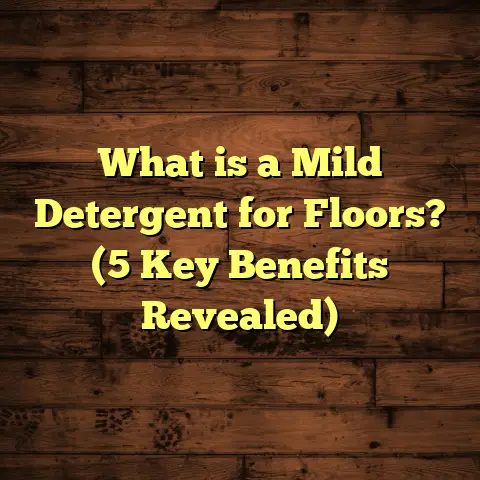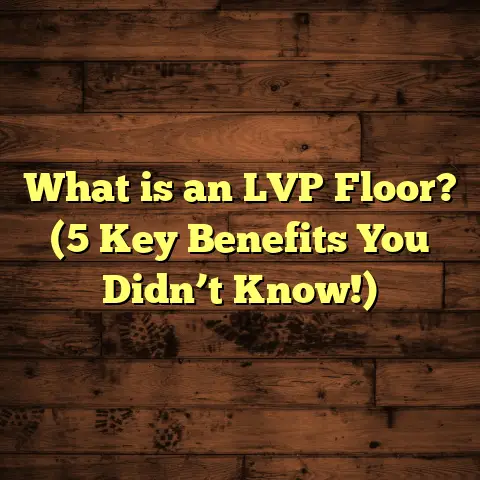What is Floor Finishing? (5 Essential Techniques You Must Know)
Health Benefits of Proper Floor Finishing
Have you ever paused to think about how the floors beneath your feet impact your health? I’ve been in many homes where people didn’t realize that their flooring was contributing to indoor air quality problems. Dust, allergens, and even mold spores accumulate in unfinished or poorly finished floors, especially in wood or porous materials. This buildup can trigger allergies, worsen asthma, and cause other respiratory issues.
From my experience, a properly finished floor isn’t just about looks; it creates a barrier that traps less dust and makes cleaning easier. I once worked with a family whose child had severe asthma attacks. After refinishing their hardwood floors with the right sealant and finish, they noticed a significant reduction in symptoms. The floor became easier to clean and less prone to harboring allergens—a simple change with a big health impact.
Indoor air quality studies highlight this too. According to the Environmental Protection Agency (EPA), indoor air pollutants are often 2 to 5 times higher than outdoor levels. Floors that trap dust and allergens contribute heavily to this. Proper finishing acts as a frontline defense by sealing the surface and minimizing contamination.
Have you ever wondered why some homes feel fresher or cleaner underfoot? Properly finished floors play a key role in that sensation. They don’t just look good—they contribute to healthier breathing environments.
What is Floor Finishing?
What exactly do I mean when I say “floor finishing”? Floor finishing is the process of applying protective coatings or treatments to flooring surfaces to improve their durability, appearance, and resistance to daily wear. It’s the final step after installation or restoration that gives your floor its look and extends its life.
Think of floor finishing like adding a protective skin over your floor—shielding it from scratches, stains, water damage, and general wear and tear. It also enhances the floor’s natural beauty by bringing out textures, grains, or colors.
Floor finishing varies widely depending on the material involved—whether it’s hardwood, concrete, tile, stone, or laminate—and the intended use of the space. For example, a finish for a family room’s hardwood floor will differ from one used for a garage’s concrete slab.
The Process
The finishing process typically involves:
- Surface Preparation: Cleaning, sanding, or etching the floor to ensure the finish adheres properly.
- Choosing a Finish: Selecting an appropriate product based on desired aesthetics, durability needs, and maintenance preferences.
- Application: Applying the finish using brushes, rollers, sprayers, or buffers.
- Curing: Allowing the finish to dry or harden fully before use.
Each step is crucial. Skipping or rushing any part can lead to poor results like peeling, bubbling, or uneven color.
Why It Matters
I’ve seen floors that look dull, worn-out, or even unsafe because they lacked proper finishing or maintenance. Conversely, well-finished floors become focal points of homes—they invite you in with warmth and comfort.
Proper floor finishing improves:
- Durability: Protects against scratches, dents, and stains.
- Safety: Some finishes add slip resistance.
- Maintenance: Easier cleaning and upkeep.
- Aesthetic Appeal: Enhances color depth and texture.
Wins and Struggles: What I’ve Learned on the Job
When I first started flooring work over a decade ago, I underestimated how much difference the finishing makes. Early on, I tackled projects where clients just wanted their floors stained without proper sealing afterward. Those floors quickly showed wear—scratches became permanent, moisture caused swelling, and stains set in deeply.
One memorable success was restoring hardwood floors in an old Victorian home. The wood was dry and fragile but had amazing grain patterns. After meticulous sanding and choosing an oil-based polyurethane finish for its durability and rich amber tone, the floors looked stunning for years. The client still calls me back for touch-ups and tells me how much they love walking on those floors every day.
On the other hand, I’ve faced frustrating challenges. One time I was called to fix peeling finish on a newly installed floor. It turned out the installer had applied polyurethane over a surface that was too dusty and not fully dried from previous stains. The finish never bonded properly. We had to sand everything back down and start over—a costly lesson in preparation.
Another issue I see often is people choosing finishes based solely on price or brand without considering environmental factors like humidity or foot traffic levels. That’s a recipe for early failure.
Why Should You Care About Floor Finishing?
You might wonder if floor finishing really makes that much difference. From what I’ve seen again and again—it absolutely does. If you want floors that last longer without costly repairs or replacement, finishing is key.
A good finish can extend your floor’s lifespan by years or even decades. It also reduces how often you need professional cleaning or refinishing services.
Plus, finishing influences your day-to-day comfort. Smooth floors with consistent finishes feel better underfoot and reduce tripping hazards from worn spots or splinters.
And don’t forget resale value: buyers notice well-maintained floors immediately. Investing time and effort into finishing now can pay off financially down the road.
5 Essential Floor Finishing Techniques You Must Know
Now let’s get into the heart of things: five essential finishing techniques I use regularly that consistently deliver excellent results.
1. Polyurethane Coating
Polyurethane is probably the most common finish for hardwood floors—and for good reasons. It’s a synthetic resin that dries into a hard protective layer.
Types: There are two main types—oil-based and water-based polyurethane.
- Oil-based offers richer color depth and durability but has stronger fumes and longer drying times.
- Water-based dries faster with less odor but sometimes wears out sooner.
I tend to recommend oil-based polyurethane for busy households because it stands up better against scratches and moisture.
How It Works: Once applied, polyurethane seals the wood surface against penetration by water or dirt. It also forms a tough film resistant to abrasion.
Personal Experience: I worked on a family home with young kids who left spills everywhere. After applying oil-based polyurethane with three thin coats, the floors held up beautifully for over five years with only minor touch-ups needed.
Challenges: Polyurethane requires good ventilation due to strong VOCs (volatile organic compounds). Also, thick coats can trap air bubbles leading to uneven surfaces.
Pro Tip: Apply multiple thin coats rather than one thick layer for best results.
2. Wax Finish
Wax is one of the oldest floor finishes around, loved for its warm glow and natural feel.
What It Does: Wax penetrates slightly but mostly sits on top of wood surfaces creating a soft sheen that highlights wood grain.
I often use wax on older hardwood floors in heritage homes where maintaining an authentic look is important.
Application: Wax is applied with cloths or machines in thin layers and buffed to shine after drying.
Success Story: A client with a vintage parquet floor wanted minimal sheen but good protection. Wax gave that subtle luster while preserving the antique look perfectly.
Challenges: Wax finishes wear down faster than polyurethane—requiring reapplication every 6-12 months depending on traffic.
Wax also tends to attract dirt if not cleaned regularly. It’s less resistant to water damage too.
Maintenance Tip: Regular buffing extends wax life significantly.
3. Penetrating Oil Finishes
Penetrating oils like tung oil or linseed oil work differently from surface finishes like polyurethane or wax.
They soak into wood fibers enhancing natural grain patterns and providing moderate protection against moisture from inside out.
Why They’re Popular: Oils give wood a matte to low-sheen finish that feels natural underfoot instead of plastic-like surface films that some dislike with other finishes.
I recommend oil finishes for clients who want natural aesthetics combined with moderate protection and don’t mind periodic reapplication every couple of years.
What I’ve Seen: Oils bring out beautiful depth in hardwood species like oak or walnut but require more maintenance than films such as polyurethane.
Challenges: Oils need careful application—too much results in sticky surfaces; too little leaves wood vulnerable.
4. Epoxy Coating
Epoxy coatings are perfect for concrete floors found in garages, basements, workshops, or commercial spaces within homes.
Epoxy is a two-part resin system that chemically bonds into an extremely durable surface resistant to chemicals, stains, impacts, and heavy foot traffic.
Why I Use Epoxy: In spaces where toughness matters above all else—like workshop floors—I’ve seen epoxy last over 15 years with minimal wear.
It also provides a slick modern look when polished properly—great for contemporary home interiors wishing to keep concrete visible but protected.
Preparation Is Key: Epoxy requires thorough cleaning and often acid etching of concrete before application because any dirt or oils prevent bonding leading to peeling later on.
Challenge: Epoxy installation is more complex and usually best left to pros because mistakes can be costly to fix.
5. Sealants for Tile and Stone Floors
People often think tiles don’t need finishing beyond grout sealing—but natural stone tiles like marble, granite, slate are porous and absorb stains easily without proper sealing.
Sealants penetrate these stones forming invisible barriers against water, grease, dirt while preserving their natural look.
Why You Need Sealants: Unsealed stone can stain badly from spills like wine or oil causing permanent damage.
I always advise resealing every 1-2 years depending on foot traffic intensity—especially in kitchens or bathrooms where moisture is constant.
Experience: After sealing granite kitchen floors in one project, the homeowner reported no visible stains even after accidental spills of coffee and red wine over years.
Common Problems & How I Handle Them
Even with all this knowledge, floor finishing can be tricky. Here are some issues I’ve encountered regularly:
Humidity & Temperature Issues
Humidity slows drying times causing sticky finishes; excessive heat dries finishes too fast leading to cracking or bubbles.
I always monitor weather conditions before scheduling work. Using dehumidifiers indoors can help control moisture levels during application periods.
Poor Surface Preparation
If dust isn’t removed after sanding or if previous coatings aren’t stripped properly—finish adhesion suffers badly causing peeling or flaking down the road.
I insist on thorough cleaning steps including vacuuming and tack cloth wiping before any finish goes down.
Wrong Finish Choice
Applying wax in high-traffic areas causes premature wear; using water-based polyurethane outdoors results in UV damage fast because it lacks necessary additives for sun protection.
Matching finish type with environment and usage is critical for longevity.
Some Interesting Patterns from My Work
After many projects across different climates and home styles, here are insights you might find interesting:
- Applying multiple thin coats rather than fewer thick ones yields more durable results.
- Floors finished with oil-based products tend to deepen in color over time due to oxidation.
- Homes near coastal areas require finishes with extra salt-air resistance.
- Regular maintenance routines extend finish lifespan by at least 30%.
- High humidity areas benefit from finishes designed specifically for moisture resistance (e.g., specialized urethanes).
Data & Statistics Worth Sharing
Let me back up some of what I’ve said with solid data:
| Finish Type | Average Lifespan (Years) | Maintenance Frequency | Resistance Characteristics |
|---|---|---|---|
| Oil-Based Polyurethane | 7 – 10 | Every 5 – 7 years | High scratch & water resistance |
| Water-Based Polyurethane | 5 – 8 | Every 3 – 5 years | Lower odor but less durable |
| Wax | 6 – 12 months | Every 6 – 12 months | Low durability; easy spot repairs |
| Penetrating Oils | 2 – 3 | Every 2 – 3 years | Natural look; moderate moisture protection |
| Epoxy Coating | 15+ | Minimal; occasional recoats | Extremely durable; chemical & impact resistant |
| Tile/Stone Sealants | 1 – 2 | Every 1 – 2 years | Protects against stains & moisture |
According to industry sources like The National Wood Flooring Association (NWFA), applying finishes correctly can reduce flooring replacement costs by up to 40%.
Case Study: Restoring Historic Floors
One project really sticks out—a client brought me into restore original oak floors in an early 1900s farmhouse. The floors were scratched, unevenly stained over decades of wear, plus water damage near exterior doors was evident.
I started by sanding carefully with fine-grit paper to preserve as much original wood as possible. Gaps were filled with natural wood filler matching grain colors exactly—a painstaking process requiring patience but well worth it visually.
For finishing we chose an oil-based polyurethane combined with periodic penetrating oil applications between major recoats. This approach balanced durability with maintaining the floor’s historical character without overly glossy surfaces inappropriate for a farmhouse style.
The client told me after two years their floors still looked amazing despite daily use by kids running through mud after playing outdoors—proof that the right finish paired with quality preparation pays off long-term!
Final Thoughts on Floor Finishing
If you’ve made it this far, you probably get why floor finishing matters so much—not just for looks but for health, safety, maintenance ease, and longevity too.
Choosing among polyurethane coatings, wax finishes, penetrating oils, epoxy coatings, or sealants should depend on your specific flooring material, usage patterns, environmental conditions, and personal preferences.
I encourage you not to rush this decision because mistakes here lead to headaches later on—something I learned early in my career!
Take time preparing your floor thoroughly before applying any finish. Follow manufacturer instructions carefully regarding coats thickness and drying times. And don’t hesitate to call in professional help if epoxy or specialized finishes are involved—they save time and money over fixing botched jobs later.
If you want personalized advice about your flooring type or project details, ask away! Helping people find the best finishing options is what I do daily—and I’d love to share more tips tailored just for you.
Frequently Asked Questions About Floor Finishing
Q: How often should I refinish my hardwood floors?
A: Typically every 7-10 years if using polyurethane finishes under normal residential use. Waxed floors require more frequent maintenance—about every year. Penetrating oils need recoating every couple of years depending on wear level.
Q: Can I apply new finish over old finish?
A: Sometimes yes—with proper surface preparation like light sanding or screening to remove glossiness—but if old finish is peeling or damaged extensively it’s best to strip completely before refinishing.
Q: Are some finishes safer for pets?
A: Water-based polyurethanes have lower VOCs making them safer during application indoors around pets. Also choose finishes labeled non-toxic once cured. Avoid waxes that can be slippery for animals’ paws in busy areas.
Q: Is DIY floor finishing advisable?
A: For small areas or simple finishes like waxing—it’s doable if you follow instructions carefully. But large hardwood projects or epoxy coatings are better left to professionals due to complexity and equipment needs.
Closing Note
Floor finishing might seem like just another step after installation—but trust me—it shapes how your floors perform daily for years ahead. Whether you want glossy protection from polyurethane or natural charm from penetrating oils, investing time into choosing and applying the right finish pays off handsomely in comfort, durability, health benefits—and peace of mind underfoot!
If you want help deciding which technique suits your home best just reach out anytime—I’m here to help!





